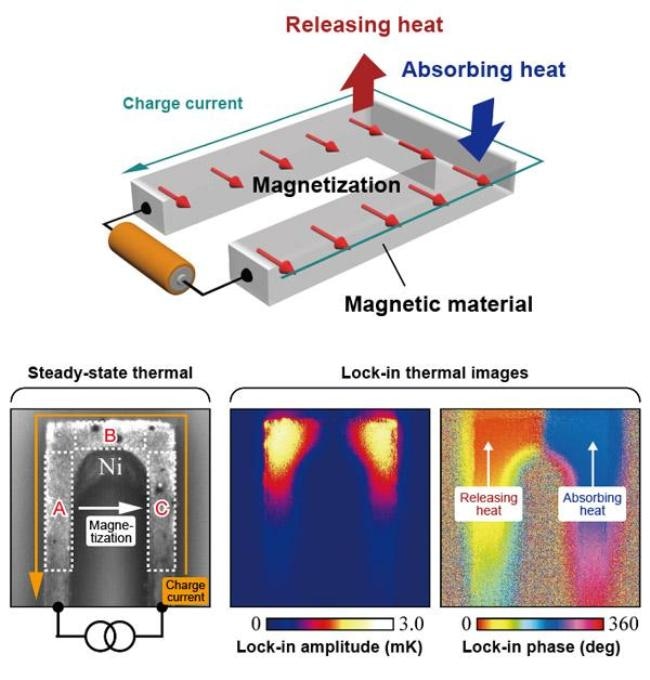Jun 19 2018
Researchers from NIMS and Tohoku University have together noticed an anisotropic magneto-Peltier effect for the first time ever. The effect is a thermoelectric conversion phenomenon where heating and cooling are induced by simple redirection of a charge current in a magnetic material.
 Experimental configuration for measuring the anisotropic magneto-Peltier effect and lock-in thermal images of a U-shaped ferromagnet. (Image credit: NIMS)
Experimental configuration for measuring the anisotropic magneto-Peltier effect and lock-in thermal images of a U-shaped ferromagnet. (Image credit: NIMS)
Traditionally, thermoelectric heating and cooling are realized by the application of a charge current to a junction between two distinctive electrical conductors. In this study, the researchers demonstrated an innovative thermal control function with the help of a single magnetic material without using a junction structure. Despite being one of the basic thermoelectric conversion phenomena, the anisotropic magneto-Peltier effect was unobserved for a long time. The team believes that this study will prompt further developments in fundamental and applied research on thermoelectric conversion.
The thermoelectric effect can be applied for realizing conversion between charge and heat currents in semiconductors and metals. A more familiar instance of the conversion is the Peltier effect, in which a charge current can be applied to heat or cool a conductor. Despite being discovered nearly two centuries ago, worldwide studies on the Peltier effect are ongoing to date in an attempt to optimize the thermoelectric conversion efficiency in electronic devices and to use this phenomenon in a broader range of technologies, such as the development of more energy-efficient computers.
The NIMS-headed team adopted a thermal measurement method known as lock-in thermography to take systematic measurements of variations in temperature in a magnetic material when a charge current was applied. Consequently, variations in the Peltier coefficient were observed with respect to the angle between the direction of the charge current and the direction of the magnetization in the magnetic material. Earlier, it was observed that the Seebeck effect—a phenomenon in which a charge current is produced by a temperature difference between a conductor—varies with respect to the direction of magnetization; this is known as the anisotropic magneto-Seebeck effect. However, it was not possible to observe the anisotropic magneto-Peltier effect, which is equivalent to the anisotropic magneto Seebeck effect, before this study.
By applying the anisotropic magneto-Peltier effect, the thermoelectric temperature of a magnetic material can be controlled by just redirecting a charge current in the material and forming a non-uniform magnetization configuration within it, instead of forming a junction between two different electrical conductors. In forthcoming research works, efforts will be made to identify and create magnetic materials that demonstrate large anisotropic magneto-Peltier effects and use them for developing thermal management technologies that render electronic devices energy efficient.
This study was performed by Ken-ichi Uchida (Group Leader, Spin Caloritronics Group, Research Center for Magnetic and Spintronic Materials, NIMS), Ryo Iguchi (Researcher, Spin Caloritronics Group, Research Center for Magnetic and Spintronic Materials, NIMS), Shunsuke Daimon (Graduate Student, Institute for Materials Research and Advanced Institute for Materials Research, Tohoku University; currently Assistant Professor of The University of Tokyo) and Eiji Saitoh (Professor, Institute for Materials Research and Advanced Institute for Materials Research, Tohoku University; currently Professor of the University of Tokyo).
The study was principally supported by the JST Strategic Basic Research Program CREST (JPMJCR17I1) and the JSPS Grant-in-Aid for Scientific Research (A) (JP15H02012).